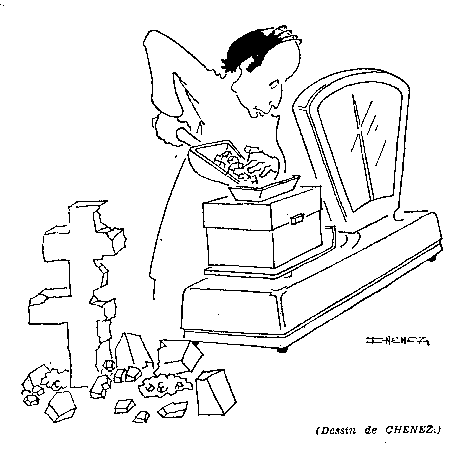
About 1,000 mathematical models constructed by Albert Harry Wheeler, along with templates for making them, are housed in the mathematics collection of the National Museum of American History, at the Smithsonian Institution. See "Mathematical Treasures of the Smithsonian Institution", by Allyn Jackson, in Notices of the AMS, vol. 46 (1999), pages 528-534.
The following political cartoon appeared in Le Monde about the same time as Pierre Berloquin's problems, numbers 13 and 16, on dissecting a cross of Lorraine to a square. Specifically, Berloquin had asked for an 8-piece dissection in problem 13, and had given Bernard Lemaire's dissection on March 27, 1974, page 18. On May 8, 1974, page 22, Berloquin gave another 8-piece solution by Dominique Ceugniet and announced that he had received a 7-piece dissection from a Mr. Szeps. He posed as problem 16 to find a 7-piece dissection. On the next day, May 9, this cartoon by Chenez appeared on page 3. On May 20, Berloquin gave the 7-piece solution by a Mr. Szeps, as well as a different 7-piece dissection by Bernard Lemaire.

The cartoon shows Valery Giscard d'Estaing, who was elected the president of France in 1974. He was the center-right candidate in the second round of the that election, having eliminated in the first round the Gaullist candidate, Jacques Chaban-Delmas, who had been Georges Pompidou's prime minister during 1969-72. Giscard was a technocrat who served as finance minister under deGaulle from 1962 to 1966 but was squeezed out when deGaulle formed a new government after his re-election in 1965. Subsequently Giscard formed his own party (the RI, or Républicains Indépendents), viewed as a rival of the Gaullist party (the UDR, or Union des Démocratie pour la République), and took positions in 1967 and 1969 that undermined deGaulle. Giscard's challenge of Chaban-Delmas was the final straw for the Gaullists, and they blamed him for accelerating the disintegration of their movement. The symbol of that movement was the Cross of Lorraine, which Giscard is shown demolishing.
Did Berloquin's posing of problems 13 and 16 inspire the politicians? Or the cartoonist? Or was it simply a politic coincidence? Of course I would be excited to see geometric dissection penetrating into the realm of politics. I could only hope, however, that politicians soon realize the advantages of minimizing the number of pieces!
"Harry Lindgren 1912.6.25 - 1992.7.1", by Doug Everingham, appeared in the Journal of the Simplified Spelling Society, 1993, No.1, page 35. Everingham gives a detailed description of Harry's activities and accomplishments in the field of English spelling reform.
I hope that no law enforcement officers took offense with the characterization of the "mathic cop" in Chapter 17. In any event, they should note with pride that the 7-pointed star, a police department symbol throughout California, is featured in the hinged dissection on the dust jacket of the book.
Copyright 1997-99, Greg N. Frederickson.
Permission is granted to any purchaser of
Dissections: Plane & Fancy
to print a copy
of this page for his or her own personal use.
Last updated April 14, 1999.